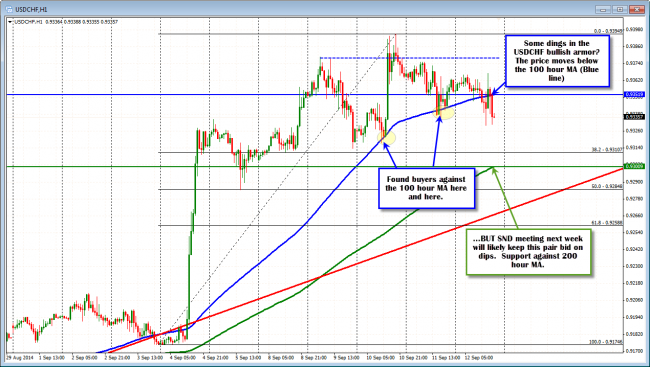The USDCHF has trended modestly to the upside in trading this week after surging higher last week on the SNB comments that they could lower rates to below 0% at their September 18th policy meeting. Well, that meeting will be coming up next week. So the threat for a change is moving closer. IF they do act and or jawbone the market more forcibly, it would be bullish for the USDCHF (bearish for the CHF).

USDCHF shows some profit taking dings in the bullish armor but care is warranted in the pair.
Meanwhile from a technical perspective, the price of the USDCHF is showing some bearish signs as we head into the weekend. The price has moved below the 100 hour MA (blue line in the chart above) after finding support buyers against the level on Wednesday and again on Thursday (for the most part).
Does the move below the trend line tempt me to sell? I would not be so fast on this one. First of all it is Friday and end of week position squaring is likely the chief catalyst for the move lower.
Most importantly, however, is that although the USDCHF and the EURCHF have both moved off low levels since last week (the EURCHF is at 1.2095 currently – more comfortably above the 1.2000 floor level), the meeting and potential actions/words will be a fresh fear in traders minds next week. The risk remains for a potential surprise and/or stronger jawboning.
Now it is true that there is time between now, and that decision next week, and the price could indeed correct some more of the gains. However, I would still not be in a hurry to trade against the current up trend. In fact, if I had a choice I would rather stick a bid below against say the 200 hour MA at 0.9300, and see if there is a pre-meeting rally back higher before the decision.
When event risk looms and that risk is slanted (in this case for a higher USDCHF and EURCHF for that matter), it is best to adjust your technical view to reflect and instead look for trade levels that define and limit risk and support the fundamental bias (i.e., buy dips).



